
Sagamihara, Kanagawa prefecture. The GPS recording goes as far as Sagamihara. My bike is in Sagamihara. I fail to grasp what these statements have to do with me. They feel like answers in a TV quiz show that I am watching or something in a book I’m reading. I look at my gray rinko bag. Normally cylindrical in shape, my bike bag for train rides is squashed slightly flat. That’s because I used it as a pillow when lying down on the asphalt of the parking lot on which I am now sitting. The smartphone on my bike handle bar makes that sound alerting me that a message has just arrived. I get up and check it. “Are you OK?” It’s from my son. It’s night time and I am not sure how long I have been napping, but I am feeling a little better than I did before I slept. “I took a nap. I am in Sagamihara,” I write back.
Ah yes, I’m on this long bike ride. Gradually all the pieces fall into place in my brain. I was getting really sleepy riding back towards Tokyo on Doshi michi (Doshi road, Rt413), a rural mountain road from Yamanakako (Lake Yamanaka) to Sagamihara, so I decided to take a nap. I have done over 500 km already. Now it’s after 23:00. From here I still have three hours to go to get home. At least three hours! I get on my bike again and ride on.
How did I get there?
It all started in May, when I did the 300 km Fuji randonée (brevet ride) with AJ NishiTokyo. At the finish the organisers mentioned an event they were planning for September, their first 600 km ride ever. Individually, many had done 600 km rides and even 1200 km such as Paris-Brest-Paris, but the club had only ever organized 200, 300 and 400 km events. A full “super randonneur” (SR) series consists of rides of 200, 300, 400 and 600 km. Before putting on an official event open to the general public, they were planning to do a test run, like a dress rehearsal, for Audax Japan members only.
I didn’t get around to do the 400 km event in June, but riding to and from the 300 km event in May I had done a total of 360 km that time, so I felt this wasn’t too different. 600 km was the next step up. Scheduled for September 21/22, the event was labelled “BRMpre” as it wasn’t an official “Brevet des Randonneurs Mondiaux” event, only in preparation for one, though it was run under the same rules regarding time limits, safety precautions, etc.
In the following months I increased the number and difficulty of my weekend rides, increasing my monthly distance. When the signup for BRMpre-921 opened on the web in August I went ahead and signed up with my credit card. Next I told everyone, so I’d have to live up to the challenge. Eventually I even told my wife 😉
Preparing for the event
On August 11 I was going to do a 280 km run including the first 130 km and the last 70 km of the course, but my rear shifter cable broke less than a km from home and I had to turn back. The following weekend I went for it again, with a new shifter cable installed. It was a sizzling hot August weekend and by the time I got to the convenience store down in Izu which was going to serve as PC1 (point de contrôle 1, check point 1), I was already 1 hour behind the minimum average pace of 15 km/h. I headed on another 20 km to a train station, took a train from there to Machida station and cycled the last 30 km home.
My expectation was that I would probably run up against the time limit at one of the 7 PCs or at the finish, but I wanted to go the whole distance if possible. I did many shorter rides working on my speed, from fast 25 km rides to Shinjuku and back to 120 km double-crossings of Wada summit near Hachioji. I wasn’t sure it was going to be enough, but it should help.
After a last hard weekend a week before the event, I took it easy, just allowing my body to recover. My friend Richard who lives near the event start at Machida generously offered to let me stay over night at his place, so I could easily get to the reception for receiving the brevet card, the safety check and the ride briefing before the 05:00 start, before any trains run. I went to bed at 20:00, setting my alarm for 03:00. At 04:00 I left Richard’s apartment and headed into my adventure.


Machida to Izu
A group of 13 riders had turned up for the ride, several of them seasoned veterans who had done other 600 km, 1000 km and 1200 km rides, including Paris-Brest-Paris (PBP, 1200 km). We handed in our consent form and received our brevet cards. At around 04:45 we had our bikes checked for compliance. Two lights were needed at the rear and two at the front, as well as a reflective vest and the legally required bicycle bell. Then we were sent off into the moonlit night.
For the first couple of km the pace is always moderate as people just warm up. Once we turned into the major road leading south towards the coast, the pace picked up a bit. I found myself following behind two faster riders, mostly doing 31-33 km/h on the flat in between traffic light stops, with a couple of people behind me. It wasn’t too hard to keep the pace drafting behind them. I did keep an eye on the heart rate monitor readout of the Garmin Edge 500.
After 20 km, both riders got ahead at lights and I now found myself at the front of a group of 5 people. I kept the pace between 28 and 32 km/h, with up to 37-40 km on downhill stretches. Navigation wasn’t too difficult. There were only a few turns that I checked on Google Maps and I had used the same route on other brevets and personal rides before. Saturday morning traffic was lively as the sun rose into a cloudless sky. I felt we were drafting off all the trucks and cars heading towards the coast with us. We hit the ocean at Enoshima and turned onto the coastal road.
Soon we got to the first stop, a public toilet where I filled up both my water bottles. This was an un-timed quiz checkpoint. We had to write down the price of the most expensive item at one vending machine, as evidence we had passed through. For all seven check points (PC1-PC7) we had to buy an item (such as food) and keep the cash register receipt, which has the time and date of the purchase printed on it.
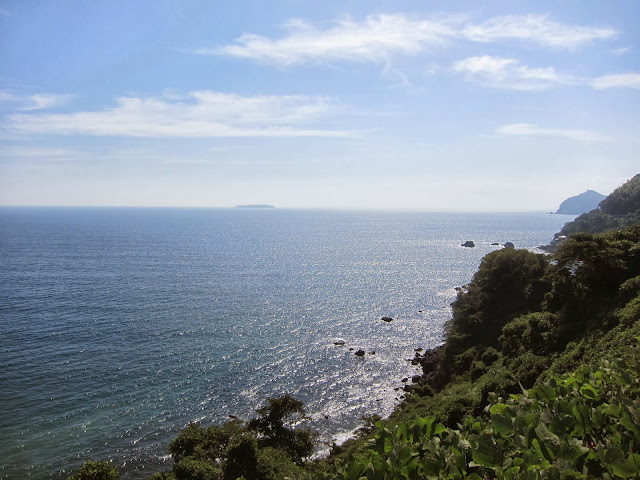
It got warmer as the sun rose higher, from 19 C at the start to 31 C by the time we were in Izu. I drank to thirst. When I think I have ridden another half an hour or so, I have another banana from my jersey pockets. When I’m out of them I stop at another convenience store, refill my water bottles from the tap and and buy another bunch of bananas again. I put 2-3 each in the left and middle jersey pockets. Every now an then I get VanHouten cocoa. Sometimes I got onigiri (rice balls wrapped in sea weed) or yoghurt or some bread, but primarily I ran on bananas.

By the time we were in Numazu, Shizuoka the heat and the early start took its toll. I caught up with riders who had passed me on the climbs between Ito and Mishima. A short pace line formed between 4 of us as we rode west on the coastal road, including the couple who had done PBP before, who I had also met at the Izu brevets (BRM309) and the Kintaro brevet (BRM413). I followed them for a while, then they dropped back and I took the pull. Until we hit more traffic lights near Fuji river we were cruising at around 30 km/h. We rode together until we reached PC2. After the break they were determined to stay with me because we made such good progress. We were over 2 hours ahead of the minimum pace.
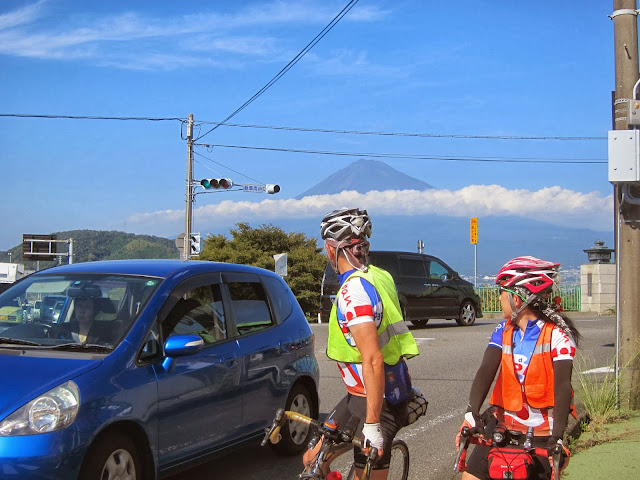
I had expected to be left behind by most riders before Enoshima and to struggle to make the cut-off time at PC1 like in my personal ride, but the combination of the slightly lower temperatures, the ease of higher speeds in a pace line and the effects of recent training was totally unexpected for me. We set off together again as we headed up Fuji river towards PC4. At some point the couple told me to go ahead. Later I saw them again as I came out of a Daily Yamazaki store with a new bunch of bananas. They stopped there for a nap, as their 02:30 start caught up with them. We didn’t meet again until near Chino.

Fuji river looked wild and muddy, fed by streams from the nearby Minami Alps. We rode through farmland and villages, where farmers were busy with the rice harvest.

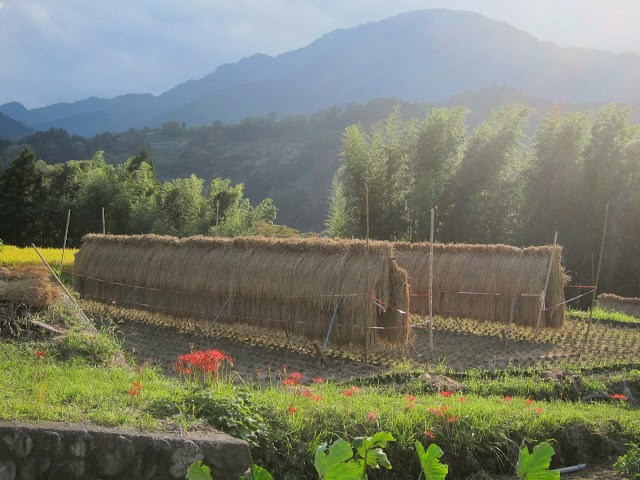


Night time
After 240 km from Machida I was 3 hours and 9 minutes ahead of the minimum pace. After sunset I arrived at PC3, 260 km from Machida. I sat down in the camping chair offered to me by the event leader and we talked while I ate some food. He told me from here it would be quite hilly, on Rt17. It would be tough from here to the lake. Knowing how much of a time buffer I had, this didn’t scare me too much.
In his opinion, the most difficult part would be the mostly downhill ride on Rt20 in Yamanashi on the way to PC5, during the second half of the brevet. He explained that it would be in the early hours of the morning when riders get sleepy and it’s the coldest. The combination of the wind and not having to pedal chills you and it makes you even more sleepy. Ooops! I had bought leg warmers and brought a wind breaker and even the set of non-cycling underwear that I had used as pyjamas at Richard’s place, so I hoped I would be all right.
He didn’t promise too much. The climbs started soon. It reminded me of the long uphill route from Odawara to Gotemba that runs in parallel to Rt246, that I knew from the Fuji brevet. I was slow, but 3 hours of time buffer is very comforting. The route wasn’t all uphill, numerous times it descended again, only to have to regain the altitude again. I put on my leg warmers and wind breaker to deal with the cold. I could see stars and at this altitude the temperature dropped rapidly. It was just me and my bike cycling past nightly fields and trees, with the occasional car or truck passing on the otherwise deserted back road. I was passed by a few other cyclists.
It seemed to take forever to get closer to Chino. I started yawning and feeling the chill. Even when I was past the worst climbing, near the lake my speed had dropped from the sleepiness and the cold. I met the couple again and they told me they were ending their ride here, checking into a hotel at Chino without going to PC4. DNF (Did not finish). I headed on towards the lake. It is about 700 m above sea level, surrounded by high mountains. Nearby Yatsugatake is popular for skiing in the winter.
I had been hoping for 24 hour restaurants such as McDonald’s to warm up and take a short nap but there were none. Finally I stopped the bike next to a metal bench, because it was the closest thing to a bed I could find. I used the rinko bag as a pillow and passed out almost immediately after I lay down. It was only about 14 C.
When I woke up again, I checked the map. I still had about 10 km to PC4 and it was around midnight. Finally I got to a busier part of the lake shore, with fast food places, but by then I was close to PC4. When I got there, the organiser was waiting outside the convenience store in his thermal clothes. Apparently, except for people who had phoned in to announce their DNF, there was no one behind me. I was still over two hours ahead of the pace, but it was 80 km to PC5, quite a bit of it chilly downhill and over 5 hours until sunrise. I would suffer hypothermia and sleep deprivation all the way. This was no way to continue. I announced my DNF. Meanwhile he had 7 hours to get some sleep and get to PC7, where the faster riders would be arriving later on.
“There are no trains now. You can get together with O.-san over there and wait until the morning at a Mac,” he helpfully explained. He woke his colleague who was sleeping in the car and then introduced me to O.-san, who had also DNFed. He rode a brand new Cherubim bike and was a software developer like me. We headed back about 3 km to the nearest 24 hour McDonald’s, ordered some food and coffee and settled in for the night. He was going to rinko back to Tokyo on one of the first trains, while my plan was to continue on the original route once it got warmer. Then I would head for a train station somewhere, maybe Otsuki or Numazu.
Luckily, O.-san knew Yamanashi prefecture very well. We discussed various roads. He explained that the course headed south almost down to the coast and then climbed back up north towards the “Fuji 5 lakes” (Fujigoko) because the organisers wanted to avoid the steep climbs necessitated by any more direct routes. The route was gaining about 800 m of altitude between PC6 and PC7, when riders already had 450 km in their legs.
I checked maps and posted on Facebook. Finally we both slept, then woke up in the morning, had some breakfast and got ready. We took some pictures at the lake, exchanged contacts and went our separate ways.
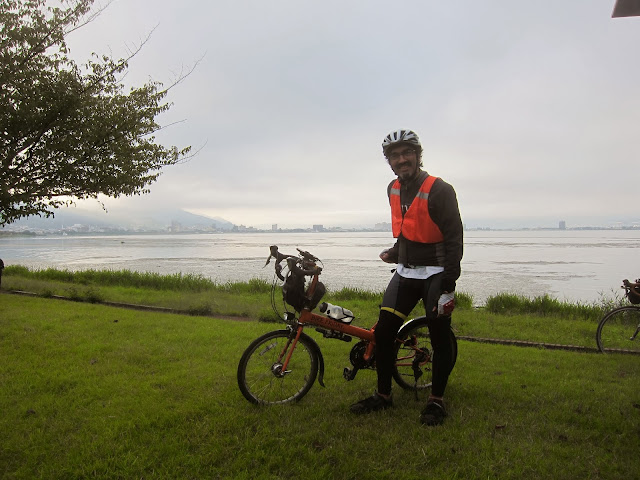
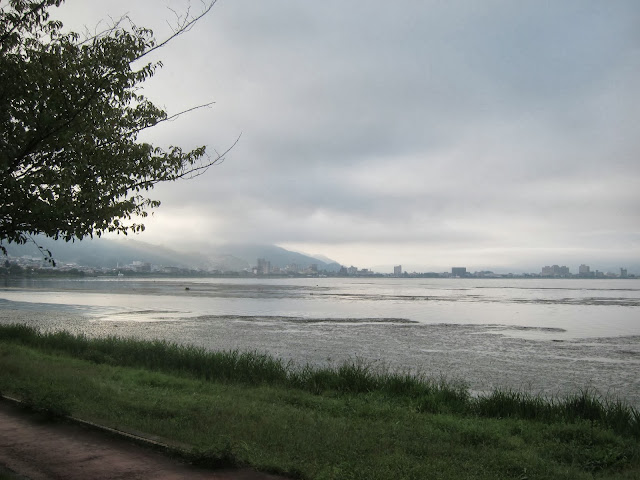
The return trip
80 km from the next PC with only 1 1/2 hours before its cut-off time the pressure was off for me, as I couldn’t make that anyway, even if I hadn’t announced my DNF. I could follow any route I chose. I still wanted to make it a decent distance, since this was probably going to stand as my longest personal ride distance for perhaps a year, assuming I were to ride a 600 km brevet next summer or autumn. Numazu was further than Otsuki, and I guessed there wouldn’t be any big climbs once I got beyond the rolling hill portion of Rt20. So I continued on the original course following Rt20, then Rt52 which joined Fuji river again. Except for the downhill coasting my speed was low. At Fuji river I left the course, staying on the big road down the river, which was fast and flat, though quite busy with cars and trucks.
I thought the busy road wasn’t really much fun, when I suddenly saw a signpost for Motosu. That was one of the short, steep climbs to get up to the Fuji 5 lake elevation and I knew the 5 lakes were nice. So I turned off onto the small road. Back through villages again, past playing kids and working farmers. I still had enough bananas for what I expected to be 2 hours of climbing.
The first steep climb took me up to a tunnel, then right down again to the starting elevation. The Motosu turn-off had been one valley too early. A bit shorter, but with bonus elevation for cyclists. I didn’t really mind. The idea of exploring new territory excited me.
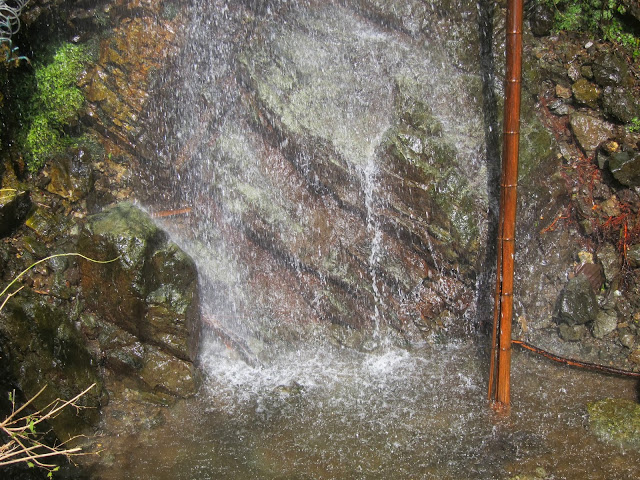
The Motosu michi climb (Rt300) turned out to be pretty nice. While it was quite sunny and hot in places, there were many streams and water falls. I seemed to be surrounded by the sound of running water everywhere. Nice! I wasn’t sure how high I had to climb and I wasn’t fast, but I didn’t hit the wall either and wasn’t sleepy. It was steady progress. As I got closer to the tunnel at the top I took pictures of the valley below and the views.

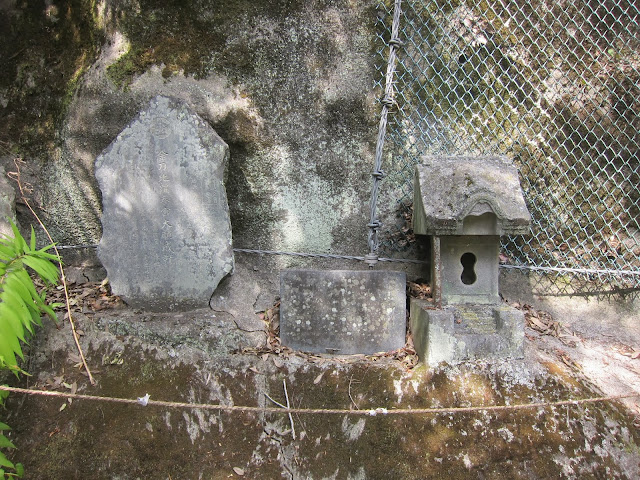


Finally I reached the tunnel that took me over to the lake side. It was about 15:00. The other riders were already on Doshi michi, after Yamanakako (Lake Yamanaka).

Rt139 from Motosuko to Yamanakako was jammed with cars. It was basically one big traffic jam, as is typical on weekends. I got to Yamanako around sunset. I was glad to be off Rt139. Now I was down to the final 100 km. I was pretty confident now I could make it back home without any train ride, though I would get sleepy again.

I was surprised just how many cars were heading east from Yamanakako on Doshi michi. The climb to the toge is mercifully short, then comes a long fun fast descent. Every now and then I let a car pass me. They were only a little faster than me on the steeper sections. Two of them were police cars. I filled up my bottles again at the Michi no eki, then headed on.
To be honest, Doshi michi was too busy for me at night. I like Doshi michi at daytime, but everybody seemed to be driving really fast and I couldn’t help wondering how many drivers had had something to drink. Towards the Sagamihara side the road has a lot of ups and downs. I climbed many hills in a low gear, just wanting to get home. I started yawning again. Finally I found a convenience store with a car park and decided to stop for a nap, because I wanted to stay safe.
This wasn’t my last nap. I was OK again through Sagamihara and Machida and took pictures at the Cherubim bike shop (the official finish line), as I had completed the loop, though with only 540 km by then and outside the time limit.
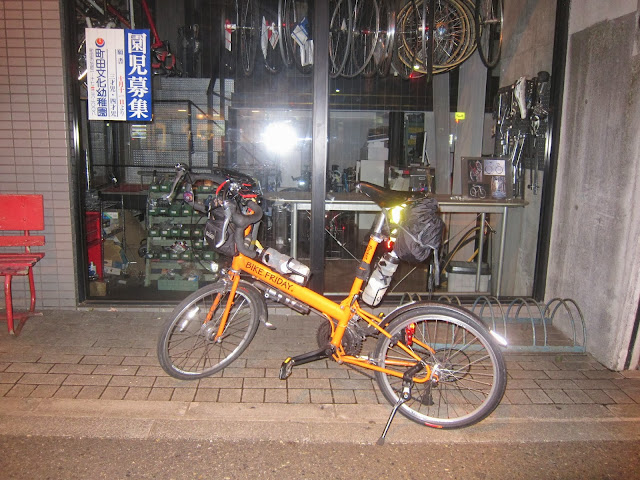
From there I headed to Onekansen. Since the afternoon I felt like I had taken some kind of mushroom that makes every hill look 2-3 times steeper than it normally is. I still got up there, but always conserving my energy. Not far from the Tamagawa bridge I had to lie down once more, taking another nap on the sidewalk. I bought a cup of coffee at a convenience store and felt OK for the final 10 km. My heart rate stayed at a mere 74 bpm while cycling on flat roads. Around 04:00 I unlocked my front door back in Setagaya. 570 km with 4949 m on the GPS. I took a shower, washed my hair and went to bed.
What I learnt from the experience
I would do it again. I plan to do the full SR series next year, with the aim of completing all ride distances within the time limit. That may mean multiple rides of each length, depending on weather conditions. I know I can ride the distance. I can manage eating and drinking and navigating for this long.
My biggest problem this time was not having brought either my winter gear or at least my rain gear as an extra thermal layer. I would have been OK temperature-wise. Lack of sleep was the other problem, but it was partly related. I couldn’t really take nap breaks outside at the higher altitudes when I wasn’t dressed warm enough.
I had no problems managing power on my Garmin Edge 500 and the phone. I kept both going with a single 8000 mAh USB battery and two sets of cables, including a special host mode cable to allow simultaneous recording an charging on the Garmin 500. The 570 km ride came out as a single FIT file recorded over 47 hours, excluding only a couple of hours where the Garmin was paused while I was inside the McDonald’s. Normally the Garmin battery will last no more than 16 hours.
Instead of using my large Carradice saddle bag, I just bundled up my things into a pastic bag, covered it in a rain cover from a rucksack and tied it to the back of the saddle with rubber bands made from cut up old bicycle tubes. I am sure it was a lot lighter and more aerodynamic. The Carradice is great for touring, but for brevets with a time limit something more streamlined will work better.
The bananas were great. They are the ideal riding fuel for me. They never upset my stomach and I don’t get tired of them.
Besides carrying the right clothes, managing sleep will be essential on brevets beyond 200 km. Lack of sleep affects me badly and I’ll need to deal better with it. Part of the solution will have to be to be able to ride faster, so I can stay ahead of the cut-off time throughout the ride even if I take enough sleep breaks to keep functioning.
Tim Smith of GS Astuto said after the Haute Route 2013 cyclosportive, if it feels like the worst day in your life, you didn’t train enough. The BRMpre-921 was not the worst day (or two days) in my life, far from it. It definitely had its ups and downs, figuratively and literally. The last 50 km were the hardest, primarily due to sleep deprivation. I was happy about my performance on the first day and I am glad I got all the way back to Tokyo after the DNF without riding a train, seeing a lot of new places.
Next time I try a 400 km or 600 km ride it will feel less intimidating. I will know what to expect and what works for me. Last but not least, I will keep working on my performance, so I can go not only further but also do it faster, which in a timed event can be a precondition for going further.
Some advice I received and discussed
Talking to other participants and organisers, I received some advice that should help me on the next 600 km or longer brevet.
Treat brevets of 600 or 1200 km as series of 300 km day rides, with sleep breaks of 3 hours or more, depending on your speed.
Organisers often lay out the course with night stops near the 300 km points in mind. Sometimes there are Kenko Land bathhouses around there, where you can take a bath and lie down for a couple of hours in the rest area. There was no 24 hour Kenko Land in Chino (some of them close after 22:00). Other people make reservations at business hotels or minshuku, though it’s relatively expensive for the short stay.
Even love hotels can be an option, as they tend to have a cheap flat rate (“stay”, not by the hour) for the night after 22:00, which is lower than a single person business hotel rate, but covers two people. The short term room rate for between 2 and 5 hours (“rest”) is cheaper than a single person minshuku rate.
Newspaper stuffed down the front of the jersey and the bib tights can help keep the cold wind off the body. This should help on cold night rides and descents.
For sleeping outdoors, a mylar blanket (space blanket) is recommended. It conserves heat but is extremely light weight.
A cap and fleece neck warmer conserves heat around the head and neck, which are like the radiator of the body. I used a cotton handkerchief tied around my head and ears for that purpose on winter rides.

